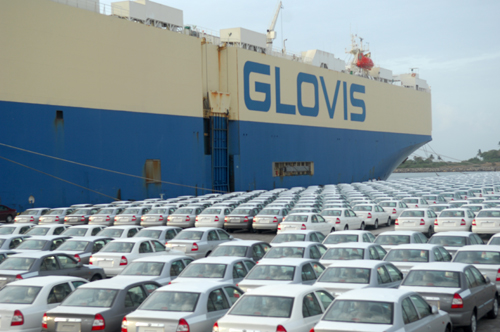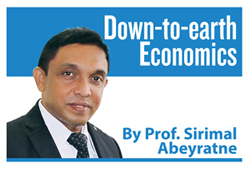New development model for Sri Lanka!
View(s):
File picture of the Hambantota Port
Last week when Sri Lanka was celebrating its 73rd Independence Day, I received an email from one of the readers of my column. He had asked me a question which inspired me to use it as today’s theme. He asked:
“What is the economic model you suggest for the development of our nation, Sri Lanka?” What an interesting question to be asked after nearly three-quarters of a century since independence!
He had explained further the reasons for raising such a question: Capitalism, Liberalism, and Neoliberalism doesn’t seem to be suitable for Sri Lanka. Neither Socialism, Communism nor State Capitalism models are going to work here. Sri Lanka needs our own model for development – a new model! Then, what should it be?
In fact, the question is not an isolated one. There are many arguments and debates along similar lines of reasoning in favour of the idea that “we need a new model”. There is even blame for economists and policy makers, for repeating the same thing over the years and decades without bringing about a “new model” suitable for Sri Lanka.
Old models and new challenges
It was a big old story during the time I learnt development economics that the Western countries have achieved development through colonization and exploitation over 100s of years. They “kicked off the ladder” after development and, shifted to free-market policies, adopted democratic values, and established human rights. Now they want the poorer countries to pursue their free-market policies, democratic values and human rights in order to achieve development, which is not the way they achieved it. It was the Western model, although it is not possible to group all the Western countries into the same basket.
It is, however, a fact that many Asian countries have telescoped the Western development that cost the sacrifice of generations into a rapid transformation within a single generation, even without such cruelty and cohesiveness. This means that colonization and exploitation are not the necessary conditions of development although we have seen them among some of the countries in the world. It is the East Asian model!
One of the most recent episodes that has caught intellectual attention is the challenge over the American “free-market model” posed by the successful Chinese development. Even at the turn of the century, China – the world’s largest nation by population -, contributed only 3.6 per cent of world GDP. Now, 20 years later China contributes over 16 per cent of world GDP and has become the second largest economy in the world after the US. And it is only a matter of time before China becomes the world’s biggest economy. After all it is China’s own model which enabled China to ensure a rapid pace of development without losing the characteristics of the Chinese Communist system.
Whichever the model that we have seen in different parts of the world – the West, the US, East Asia, Southeast Asia, China or any other, and at different times of history, what is fascinating is that the “economic fundamentals” of development are the same. These fundamentals that drive nations to achieve their prosperity are not different between the Western and the East Asian countries or between the US and China. Let me explain some of them.
Where is capital?
First and foremost, as we all know, achieving prosperity requires “expansion in business activities” which may be in agriculture or industry or services sectors. It depends on the availability of (1) both primary inputs (capital, labour and technology) and secondary inputs (raw materials, parts and components) on the one hand and (2) a market for output sales (local and global) on the other hand.
Here lies the problem: If we anticipate a big difference in our progress, there is no doubt that the amount of capital required for investment has to be big too. If we anticipate 7 – 8 per cent rate of annual economic growth for Sri Lanka, the initial amount of investment that Sri Lanka needs is roughly about an additional US$ 10 billion a year; then, it should grow as time passes.
 The question is “where is the capital to invest?” Some of us might think that it is in the hands of government, but it’s not so. All over the world, including in China where the government is playing a bigger role even in business, a greater share of investment comes from the private sector. Then the problem is that the “local private sector” in a developing country is “too small” to generate a big investment flow and thus must rely on foreign investment.
The question is “where is the capital to invest?” Some of us might think that it is in the hands of government, but it’s not so. All over the world, including in China where the government is playing a bigger role even in business, a greater share of investment comes from the private sector. Then the problem is that the “local private sector” in a developing country is “too small” to generate a big investment flow and thus must rely on foreign investment.
One could say that some countries have robbed the other nations to accumulate capital, and then to invest; true, but it’s not the only way to accumulate capital. Someone could argue that a nation can save more and more money from its own income and generate capital, little by little and year by year for investment; this is also true, if a nation is willing to wait for 100s of years to achieve some progress.
If the government decides to invest in businesses, however, there is no question that it should have enough tax money or non-tax money. Even if the government decides to borrow money and invest, it should also have the capacity to run its businesses, which are the “state-owned enterprises (SOEs)”, efficiently and profitably.
It’s a choice
After all, it’s all about a choice that a country has to make about how big it expects in the amount of capital, where to find it, and how to get it; what everyone needs is just capital for investment.
Labour is not just the number of people, but also the “productive quality” of people in terms of globally competitive knowledge, skills and attitudes. If the anticipated investment is big and globally competitive, then it also requires a large number of ‘high quality” labour. If an investor is looking to hire a group of “world-class” professionals for his business investment, how does the country make sure that such labour is available without any shortage?
A labour force with that “world-class” professionalism must either be trained and built at home or hired from the rest of the world as some countries do. It’s also a choice for a nation to opt for a pragmatic way of finding quality labour. In the world, there is no shortage of technology – the stock of knowledge about transforming inputs into output. It is a choice too whether we like to get it from where it is available or not. It is not unusual that the secondary inputs – raw materials, parts and components, may not be available in sufficient quantity and quality within a country; but they all are available in the world. Therefore, it is also a choice of the country either to make it freely available or not.
If the anticipated output is big, then it also needs a big market to sell it otherwise the size of the market inevitably limits the progress. The “local market” of every country, including China, India, EU, Japan, and US, is too small for their output market. Therefore, they all look for the “global market” as their output market. It is also a choice that a nation has to make whether it chooses itself to be open to the smaller local market or look at the bigger global market.
It’s the same thing
When all these economic fundamentals of prosperity are a “set of choices” that a nation has to make, then there is no use of “labeling” a set of choices of a country. The Western countries may have done it differently, and the East Asian countries differently. The US has done it differently, and China differently. But the fundamentals of prosperity are the same!
Let me conclude by quoting from the speech of Xi Jinping, the President of China, at the virtual Davos Agenda event held by the World Economic Forum (WEF) on 25 January 2021: “We will foster a business environment that is based on market principles, governed by law and up to international standards….” What is implied by this quotation is that those nations which strive to market principles, rule of law and international standards will prosper; and as we have explained, it’s a choice of a nation.
(The writer is a Professor of Economics at the University of Colombo and can be reached at sirimal@econ.cmb.ac.lk and follow on Twitter @SirimalAshoka).



